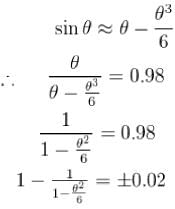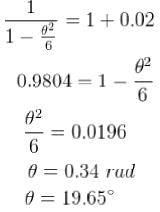Physics Exam > Physics Questions > For a simple pendulum, find the angular displ...
Start Learning for Free
For a simple pendulum, find the angular displacement at which the restoring torque required for simple harmonic motion deviates from the actual restoring torque by 2% use g = 10m/s2 . (θ in degrees).
Correct answer is '19.65'. Can you explain this answer?
| FREE This question is part of | Download PDF Attempt this Test |
Verified Answer
For a simple pendulum, find the angular displacement at which the rest...
The restoring torque on the bob of the pendulum at an angle with the vertical is given by

We apply small angle approximation to so that the motion can be followed as simple harmonic motion, the torque becomes

The problem requires to find the value of 9 for which

Write the taylor expansion of Sin θ

Taking absolute value on both sides

The correct answer is: 19.65

We apply small angle approximation to so that the motion can be followed as simple harmonic motion, the torque becomes

The problem requires to find the value of 9 for which

Write the taylor expansion of Sin θ

Taking absolute value on both sides

The correct answer is: 19.65
Most Upvoted Answer
For a simple pendulum, find the angular displacement at which the rest...
The restoring torque for a simple pendulum is given by the equation:
τ = -mgl sin(θ)
where τ is the torque, m is the mass of the pendulum bob, l is the length of the pendulum, g is the acceleration due to gravity, and θ is the angular displacement.
For small angles of displacement (θ), sin(θ) can be approximated by θ in radians.
Therefore, the restoring torque can be approximated as:
τ ≈ -mglθ
The actual restoring torque is given by:
τ_actual = -mgl sin(θ)
To find the angular displacement at which the restoring torque required for simple harmonic motion deviates from the actual restoring torque by 2%, we can set up the following equation:
0.02τ_actual = |τ - τ_actual|
Substituting the approximated restoring torque, we have:
0.02(-mgl sin(θ)) = |-mglθ - (-mgl sin(θ))|
Simplifying the equation, we get:
0.02mgl sin(θ) = |mglθ + mgl sin(θ)|
Dividing both sides by mgl, we have:
0.02 sin(θ) = |θ + sin(θ)|
Since sin(θ) is always positive, we can simplify the equation further:
0.02 sin(θ) = θ + sin(θ)
To solve this equation, we can use numerical methods such as the Newton-Raphson method or graphical methods.
Note: This equation does not have a simple analytical solution, so numerical methods are required to find the value of θ at which the restoring torque deviates by 2%.
τ = -mgl sin(θ)
where τ is the torque, m is the mass of the pendulum bob, l is the length of the pendulum, g is the acceleration due to gravity, and θ is the angular displacement.
For small angles of displacement (θ), sin(θ) can be approximated by θ in radians.
Therefore, the restoring torque can be approximated as:
τ ≈ -mglθ
The actual restoring torque is given by:
τ_actual = -mgl sin(θ)
To find the angular displacement at which the restoring torque required for simple harmonic motion deviates from the actual restoring torque by 2%, we can set up the following equation:
0.02τ_actual = |τ - τ_actual|
Substituting the approximated restoring torque, we have:
0.02(-mgl sin(θ)) = |-mglθ - (-mgl sin(θ))|
Simplifying the equation, we get:
0.02mgl sin(θ) = |mglθ + mgl sin(θ)|
Dividing both sides by mgl, we have:
0.02 sin(θ) = |θ + sin(θ)|
Since sin(θ) is always positive, we can simplify the equation further:
0.02 sin(θ) = θ + sin(θ)
To solve this equation, we can use numerical methods such as the Newton-Raphson method or graphical methods.
Note: This equation does not have a simple analytical solution, so numerical methods are required to find the value of θ at which the restoring torque deviates by 2%.

|
Explore Courses for Physics exam
|

|
Similar Physics Doubts
For a simple pendulum, find the angular displacement at which the restoring torque required for simple harmonic motion deviates from the actual restoring torque by 2%use g = 10m/s2 . (θ in degrees).Correct answer is '19.65'. Can you explain this answer?
Question Description
For a simple pendulum, find the angular displacement at which the restoring torque required for simple harmonic motion deviates from the actual restoring torque by 2%use g = 10m/s2 . (θ in degrees).Correct answer is '19.65'. Can you explain this answer? for Physics 2024 is part of Physics preparation. The Question and answers have been prepared according to the Physics exam syllabus. Information about For a simple pendulum, find the angular displacement at which the restoring torque required for simple harmonic motion deviates from the actual restoring torque by 2%use g = 10m/s2 . (θ in degrees).Correct answer is '19.65'. Can you explain this answer? covers all topics & solutions for Physics 2024 Exam. Find important definitions, questions, meanings, examples, exercises and tests below for For a simple pendulum, find the angular displacement at which the restoring torque required for simple harmonic motion deviates from the actual restoring torque by 2%use g = 10m/s2 . (θ in degrees).Correct answer is '19.65'. Can you explain this answer?.
For a simple pendulum, find the angular displacement at which the restoring torque required for simple harmonic motion deviates from the actual restoring torque by 2%use g = 10m/s2 . (θ in degrees).Correct answer is '19.65'. Can you explain this answer? for Physics 2024 is part of Physics preparation. The Question and answers have been prepared according to the Physics exam syllabus. Information about For a simple pendulum, find the angular displacement at which the restoring torque required for simple harmonic motion deviates from the actual restoring torque by 2%use g = 10m/s2 . (θ in degrees).Correct answer is '19.65'. Can you explain this answer? covers all topics & solutions for Physics 2024 Exam. Find important definitions, questions, meanings, examples, exercises and tests below for For a simple pendulum, find the angular displacement at which the restoring torque required for simple harmonic motion deviates from the actual restoring torque by 2%use g = 10m/s2 . (θ in degrees).Correct answer is '19.65'. Can you explain this answer?.
Solutions for For a simple pendulum, find the angular displacement at which the restoring torque required for simple harmonic motion deviates from the actual restoring torque by 2%use g = 10m/s2 . (θ in degrees).Correct answer is '19.65'. Can you explain this answer? in English & in Hindi are available as part of our courses for Physics.
Download more important topics, notes, lectures and mock test series for Physics Exam by signing up for free.
Here you can find the meaning of For a simple pendulum, find the angular displacement at which the restoring torque required for simple harmonic motion deviates from the actual restoring torque by 2%use g = 10m/s2 . (θ in degrees).Correct answer is '19.65'. Can you explain this answer? defined & explained in the simplest way possible. Besides giving the explanation of
For a simple pendulum, find the angular displacement at which the restoring torque required for simple harmonic motion deviates from the actual restoring torque by 2%use g = 10m/s2 . (θ in degrees).Correct answer is '19.65'. Can you explain this answer?, a detailed solution for For a simple pendulum, find the angular displacement at which the restoring torque required for simple harmonic motion deviates from the actual restoring torque by 2%use g = 10m/s2 . (θ in degrees).Correct answer is '19.65'. Can you explain this answer? has been provided alongside types of For a simple pendulum, find the angular displacement at which the restoring torque required for simple harmonic motion deviates from the actual restoring torque by 2%use g = 10m/s2 . (θ in degrees).Correct answer is '19.65'. Can you explain this answer? theory, EduRev gives you an
ample number of questions to practice For a simple pendulum, find the angular displacement at which the restoring torque required for simple harmonic motion deviates from the actual restoring torque by 2%use g = 10m/s2 . (θ in degrees).Correct answer is '19.65'. Can you explain this answer? tests, examples and also practice Physics tests.

|
Explore Courses for Physics exam
|

|
Suggested Free Tests
Signup for Free!
Signup to see your scores go up within 7 days! Learn & Practice with 1000+ FREE Notes, Videos & Tests.


















